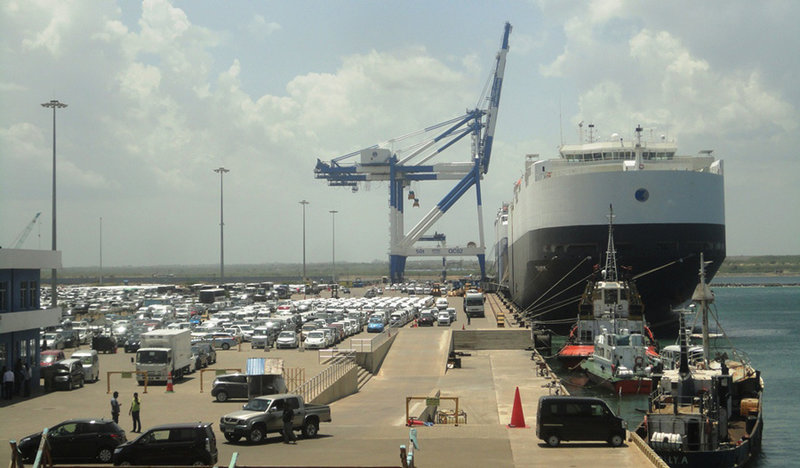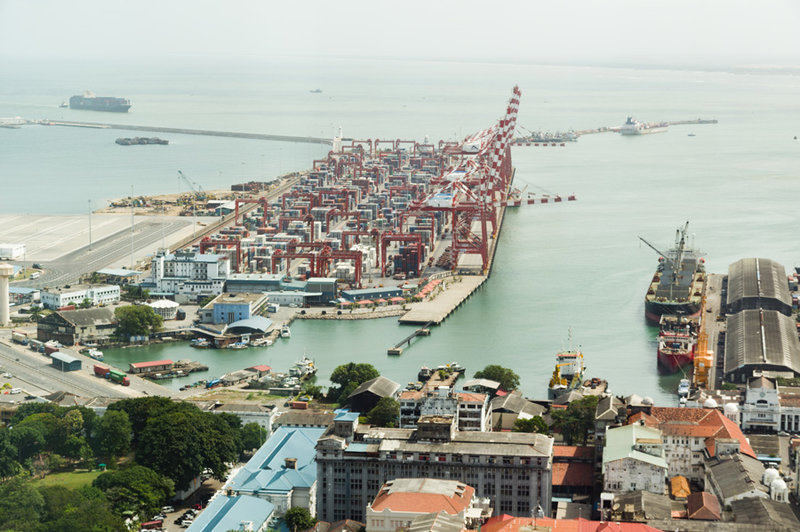Ports
The story of Hambantota Port:
a flunking token of political corruption
Over the course of seven years, Sri Lanka’s Port of Hambantota went from a bastion of hope for one of the country’s poorest districts to a dead weight that sunk its finances and turned the developing economy into China’s debtor. Eva Grey investigates
Image courtesy of
The convoluted story
behind the failing Port of Hambantota, erected with much ado on Sri Lanka’s southern shore, has become to many a clear example of the dangers posed by China’s forceful use of financial and political influence over neighbouring developing nations.
The expectations and promises of flourishing trade, new employment and wealth brought to one of the country’s poorest regions were nearly as astounding as the port’s eventual demise: Hambantota fared so badly, mostly ignored by thousands of ships passing it by daily, that it eventually defaulted on its debts and the Sri Lankan Government had little choice but to hand over 80% of the port’s ownership to China, as well as a large swathe of surrounding land on a 99 year-long lease.
Three decades in the making, Hambantota Port was repeatedly shot down by experts, with multiple feasibility studies showing it couldn’t compete with the thriving Port of Colombo, the largest in Sri Lanka, which also has plenty of potential for expansion.
Nevertheless, the warnings were ignored, and the port came to be thanks to a combination of former President Mahinda Rajapaksa’s egocentric agenda to revive his home region and main political base, and China’s opportunistic strategies to gain power in the region. Recently, a New York Times investigation revealed that many backdoor deals were struck from the project’s inception, all while the involved parties promised to deliver “the biggest port constructed on land in the 21st century”.
Today, Hambantota Port is all but abandoned, with wildlife roaming free on its mainly deserted premises. Shipping activity is scarce: according to statistics from the Central Bank of Sri Lanka, Hambantota was the only port with a negative growth rate in 2015 and 2016, and has a declining number of vessel arrivals.
The Sri Lanka Ports Authority (SLPA) attributed the port’s declining performance to the global slowdown in vehicle transhipment. But as the investigation and a collection of cables, emails and intelligence files published on WikiLeaks reveal, the story behind Hambantota’s rise and fall is far more complex than the usual struggling port struck by tough economic times.
Stuart Rivers, CEO of Sailors’ Society.
Image courtesy of Sailors’ Society
Great expectations
The idea of a port in Hambantota had been floated for about three decades, but a succession of governments ignored the proposal every time. It was only when an individual named Ariya Wickramanayake funded his own research into the port’s potential, and presented it to Rajapaksa, back then a minister, that the idea took hold.
As soon as Rajapaksa was elected president in 2005, there was renewed interest in the project, along with other big-ticket infrastructure initiatives such as an international airport, a new town, a convention centre and a highway extension, all to take place in the poorest and least developed district of Sri Lanka. Rajapaksa was also the first to lure in the much-needed Chinese investment to complete the incipient stages of the project.
The first phase of the Hambantota Port project was built through a $307m loan from the Export-Import Bank of China (Exim Bank) at 6.3% interest – a very high interest rate by all standards. At the time, SLPA said that when Sri Lanka made an open request for funding, China was the first to respond. In reality, China was the only country willing and able to throw its weight behind what was almost unanimously perceived to be a doomed project.
As the Asia Maritime Transparency Initiative notes, “the economic rationale for Hambantota is weak, given existing capacity and expansion plans at Colombo Port, fuelling concerns that it could become a Chinese naval facility,” a realisation that at the time prevented other lenders, such as India, from getting involved.
The first phase of the Port project was built through a $307m loan from China's exim Bank
A press release from the SLPA at the time captures Rajapaksa’s boastful disregard of the negative feasibility studies and his determination to overcome the “pessimistic attitudes” in his pursuit of the project.
The expectations were certainly hopeful, or at least that’s how they were sold to the public. According to a US Embassy cable published on WikiLeaks, the SLPA hoped to garner “significant business from the 70,000-80,000 ships that pass Sri Lanka's southern tip each year,” located at the heart of a busy shipping route. As such, SLPA hoped to attract up to 10,000 additional vessels each year, with a significant portion of those berthing at Hambantota.
The port was never meant to replace or directly compete with Colombo. Instead, Hambantota was to be a dedicated port of call for crude oil tankers, food and goods imports, and vehicle parts. It would therefore absorb a share of the trade between India and China and position itself as a primary bulk cargo handler for shipments to and from Pakistan and Bangladesh.
Over 50,000 indirect employment opportunities would be created, SLPA promised, which would also mean that “in a few years the Hambantota district per capita income is expected to be on par with the districts in the Western Province”. It would become the biggest harbour in South Asia, one of the biggest projects of the century, and eventually elevate the whole of Sri Lanka to a middle-income economy.


Image courtesy of
A chaotic affair
Not only were the promises of increased trade and economic wealth quashed almost immediately as the port opened its doors in a shambolic inauguration ceremony, but the project plunged Sri Lanka into spiralling debt to China.
Being China’s debtor is far from an enviable position and many fear that indiscriminate lending by China for white elephant projects in weak economies is a powerful strategy of economic and political control.
But, as a New York Times investigation revealed, it could have been an entirely preventable affair.
In 2016, statistics showed that the port was almost operating at a loss
The port never got its time in the spotlight. One year after it opened in 2010, a huge rock on the seabed was still blocking vessels from entering. Even after it was blasted away (again, at great extra expense), the port attracted only 34 ships in 2012. Still, Chinese investment continued to pour in over the following four years, as further loan agreements were signed and the price of the project increased, according to the Ministry of Finance’s annual reports.
Meanwhile the port’s performance was going from bad to worse. In 2016, statistics obtained by local media from SLPA showed that the port was almost operating at a loss, with $11.81m in revenue and incurred expenses of $10m.
Even if trade picked up considerably, administrative and operating costs would have burned a hole in the budget, forcing the port in the red and plunging the country into a debt crisis. As a result, in 2017 the Sri Lankan Government had little choice but to hand over 80% of the port’s ownership to China Merchant Port Holdings Company (CMPHC) on a 99 year-long lease, along with 1,235 acres of land. The New York Times called it a “debt trap”.

Image courtesy of
Dirty money, political ambitions and sunken egos
So, where did everything go wrong?
The port’s funding was murky from the beginning. Regardless of why Rajapaksa was so personally involved in delivering the project, money from a Chinese fund that was meant for the construction flowed directly into supporting his presidential campaign.
As local media wondered why the bidding for the project hadn’t been opened internationally and instead was handed over directly to the Chinese, WikiLeaks cables from the US Embassy in Sri Lanka to its counterparts in Bangladesh, India, China, Singapore, Mauritius, the UAE and Pakistan seemed to confirm assumptions surrounding this bad deal for Sri Lanka: “It is likely that corruption and political patronage are significant factors playing into the focus on Hambantota," one cable reads. "Often when Chinese companies win contracts, their success is due in part on their widespread distribution of graft to senior Sri Lankan Government officials.”
“China's focus on the Hambantota Port is part of its ongoing strategy to build strategic footholds in South Asia,” another wire reads. “China's long-term goal appears to be to lay the groundwork for potential access by Chinese naval vessels so China can better project power into the Indian Ocean and safeguard the growing volumes of energy supplies and other trade passing through or near Sri Lankan waters.”
In its defence, China’s foreign ministry spokesperson Lu Kang snubbed the allegations as “fake news” and “a gross distortion of facts, […] either irresponsible or engineered by people with ulterior motives.”
China's focus on the Hambantota Port is part of its ongoing strategy to build strategic footholds in South Asia
“I can tell these people that China and Sri Lanka will stay committed to advancing the cooperation on the project of the Hambantota Port in a bid to make Sri Lanka the logistics hub of the Indian Ocean,” Kang said in a press conference. “This will not only fuel the economic growth of Sri Lanka but also contribute to regional connectivity, as well as the common prosperity of the regional countries.”
How the Sri Lankan Government is going to get itself out of this mess remains unclear. Jonathan Hillman, fellow with the Simon Chair in Political Economy and director of the Reconnecting Asia Project at CSIS wrote: “Highlighting the mistakes that led to Hambantota’s handover is easier than identifying a path forward”.
Sri Lanka’s unfortunate tie-in with China raised suspicions over other similar infrastructure projects funded as part of President Xi Jinping’s One Belt, One Road initiative, which Hambantota was huddled under.
Last year, Beijing-based business news organisation Caixin reported that the country’s two policy banks, China Development Bank and Exim, gave out $200bn in loans to projects in the plan. Regardless of those deals’ anticipated success, there’s no doubt many governments will now be closely inspecting their own affairs to assess China’s degree of influence. The question is: will they be able to find a way out of any bad deals?
